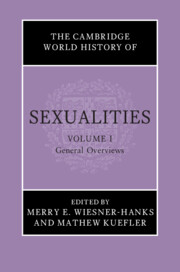Book contents
- The Cambridge World History of Sexualities
- The Cambridge World History of Sexualities
- The Cambridge World History of Sexualities
- Copyright page
- Contents
- Figures in Volume I
- Contributors to Volume I
- Editors’ Preface to the Series
- 1 The History of the History of Sexuality
- 2 The History of Sexuality and Anthropology
- 3 The History of Sexuality and Women’s History
- 4 The History of Sexuality and LGBTQ+ History
- 5 The Impact of Sigmund Freud on the History of Sexuality
- 6 Michel Foucault’s Influence on the History of Sexuality
- 7 Queer Theory and the History of Sexuality
- 8 The Sexual Body in History
- 9 Marriage and Families in the History of Sexuality
- 10 Class in the History of Sexuality
- 11 Sexuality and Race: Representations, Regulations, and Sentiments
- 12 Male Homoerotic Relations in History
- 13 Desire, Love, and Sex between Women in Global History
- 14 Trans and Gender Variant Sexualities in History
- 15 The Sale of Sex in History
- 16 Sexual Violence in History
- 17 Sexual Science in History
- 18 Sexuality and Emotion
- 19 Erotic Art in World History
- 20 Erotic Literature in History
- 21 The Material Culture of the History of Sexuality
- 22 Public History and Sexuality
- Index
- CONTENTS TO VOLUMES II, III, AND IV
- References
19 - Erotic Art in World History
Published online by Cambridge University Press: 26 April 2024
- The Cambridge World History of Sexualities
- The Cambridge World History of Sexualities
- The Cambridge World History of Sexualities
- Copyright page
- Contents
- Figures in Volume I
- Contributors to Volume I
- Editors’ Preface to the Series
- 1 The History of the History of Sexuality
- 2 The History of Sexuality and Anthropology
- 3 The History of Sexuality and Women’s History
- 4 The History of Sexuality and LGBTQ+ History
- 5 The Impact of Sigmund Freud on the History of Sexuality
- 6 Michel Foucault’s Influence on the History of Sexuality
- 7 Queer Theory and the History of Sexuality
- 8 The Sexual Body in History
- 9 Marriage and Families in the History of Sexuality
- 10 Class in the History of Sexuality
- 11 Sexuality and Race: Representations, Regulations, and Sentiments
- 12 Male Homoerotic Relations in History
- 13 Desire, Love, and Sex between Women in Global History
- 14 Trans and Gender Variant Sexualities in History
- 15 The Sale of Sex in History
- 16 Sexual Violence in History
- 17 Sexual Science in History
- 18 Sexuality and Emotion
- 19 Erotic Art in World History
- 20 Erotic Literature in History
- 21 The Material Culture of the History of Sexuality
- 22 Public History and Sexuality
- Index
- CONTENTS TO VOLUMES II, III, AND IV
- References
Summary
This chapter deconstructs the history of erotic art from prehistory to the twenty-first century. Instead of holding as self-evident the meanings of “art” and “eroticism,” it traces a history of how and why some forms of representation have been deemed erotic and the ambiguities of “art” versus “pornography.” Four related phenomena are used as anchors to explore erotic art’s long history: script, sustained long-distance contact, print, and the use of lenses and photography. These relate in turn to three important dimensions of world history: networks, or physical and informational connections between different regions of the world; technologies, mainly the means for creating and circulating visual representations but also including the pivotal technology of contraceptives; and ideologies, or how sex, eroticism, and art are defined and regarded. Contemporary conceptions of erotic art are in many ways directly traceable to key paradigm shifts in sexuality that originated in cultural, intellectual, and material interactions since the early modern period (approximately the sixteenth century). Like human history generally, the history of erotic art has been riven by hierarchies – including gendered ones usually privileging the perspectives of men – exploitation, and violence. But artistic representations of sex have also challenged long-defended hegemonies.
Keywords
- Type
- Chapter
- Information
- The Cambridge World History of Sexualities , pp. 410 - 442Publisher: Cambridge University PressPrint publication year: 2024



